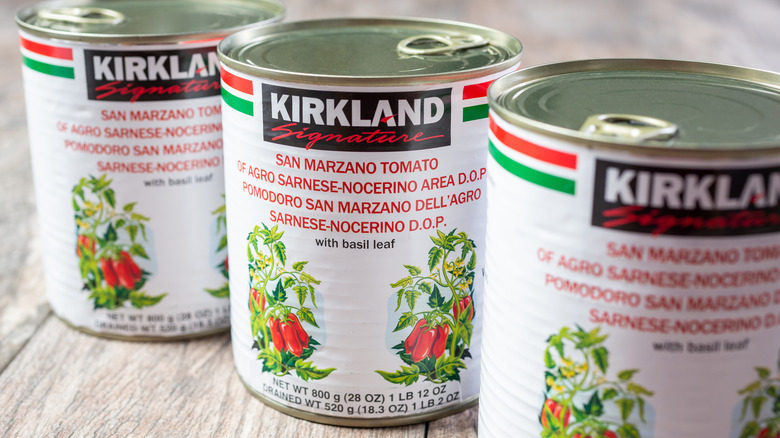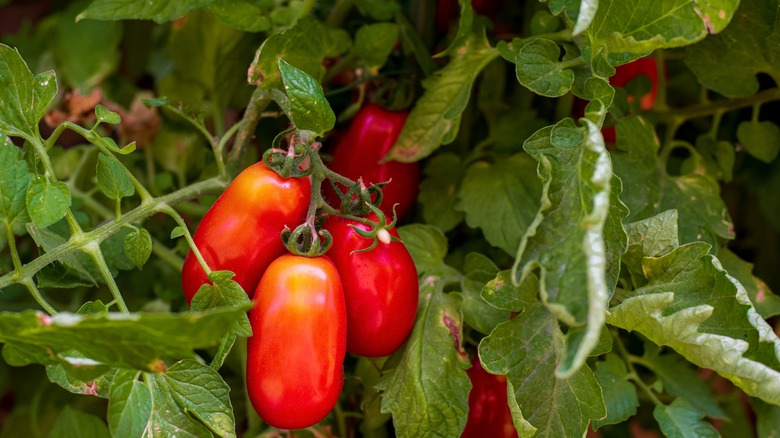When To Splurge For San Marzano Canned Tomatoes
There's quite a selection to parse through when considering canned tomatoes. Whether fire-roasted, peeled, diced, or whole, it can sometimes feel like a near-impossible task to choose the style for your cooking needs — and that's before you get to the specific variety.
For many chefs and home cooks, San Marzanos are the unquestioned stars of the canned tomato aisle. They've even garnered quite a foodie fanbase that includes Ina Garten, who can't get enough of them. Of course, these highly prized fruits also come at a much higher cost than many other varieties — usually about twice the price. So, they might not be worth using in recipes where tomatoes are relegated to the background. Rather, San Marzanos work best in dishes that allow them to shine.
The popular canned tomatoes boast a deliciously sweet yet savory flavor and a lower acid content than other types. They also have a lower moisture content than other varieties, making them less likely to yield a thin sauce. If you're looking to make the most of your San Marzano tomatoes, you should focus on using them in simpler, more tomato-focused dishes, such as spaghetti pomodoro or Bolognese, that will let the ingredient take a starring role. However, if you're making a more seasoning-rich dish, such as spicy beef chili or a traditional jambalaya, another variety will work just as well since the tomato flavor isn't won't be as prominent.
What makes San Marzano canned tomatoes so special
But what are San Marzanos? Put simply, they're a variety of plum tomatoes often used for canning. Authentic San Marzano tomatoes come with the label DOP, or Protected Designation of Origin, and only come from the Campania area in Italy, near Mount Vesuvius. San Marzanos feature a long and pointed shape, and they have fewer seeds than other varieties. While the seeds are available for purchase and are cultivated in many different places outside of Campania, these varieties aren't the real deal. So, you will want to make sure that you're splurging on authentic San Marzano tomatoes.
The flesh of a San Marzano also has a stronger, almost meaty texture that makes it a great choice for truly sumptuous sauces, soups, or even in a well-spiced Bloody Mary, if you're crafty enough. However, you will want to get the best tomatoes for your money, which means picking a quality San Marzano brand. Besides looking out for the DOP label, there are a few specific brands that stand head and shoulders above the rest. Some of the best San Marzano brands include Gustarosso DOP Whole Peeled Tomatoes, which have acquired a bit of a cult status among foodies. Cento Certified San Marzano Tomatoes are widely loved and available in many major grocery stores. Bobby Flay's favorite canned San Marzano tomatoes, meanwhile, come from Mutti in Italy.
Tips for making San Marzanos the star
If you want the unique qualities of San Marzano tomatoes to shine through, there are a few things you should keep in mind. First, you will want to stick with fresh herbs and seasonings when cooking with San Marzanos. Using fresh garlic and onion instead of dried or powdered varieties will yield the fullest flavor profile possible. This is because fresh ingredients can provide more complexity to your dish, which will further complement the taste of your tomatoes. This isn't to say onion and garlic powder don't have their place in your kitchen cabinet, they just won't bring as much to the dish.
After all, if you're investing in a can of San Marzanos, you'll want to pair them with other ingredients that can match their rich flavor, such as a parmesan cheese rind, which will add a good deal of nutty depth to any sauce, balancing the tart sweetness of the tomatoes. And, of course, you can always add fresh basil: The herb is often found floating around cans of San Marzanos anyway, so adding in a few fresh leaves will only further enhance their taste. No matter how you prepare these special plum tomatoes, you'll want to ensure they're the star of your dish. That shouldn't be hard to do, since their flavor tends to speak for itself.


